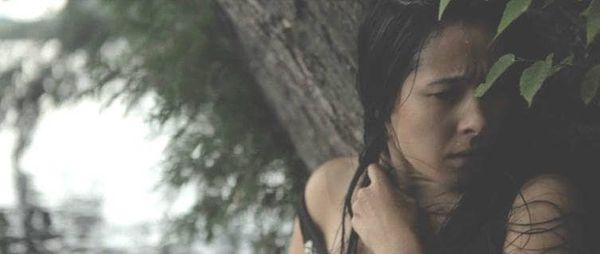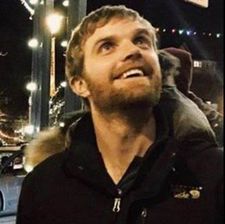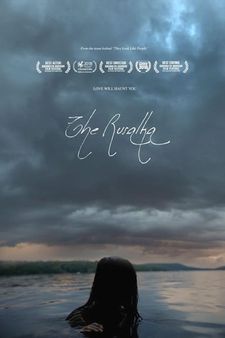 |
| Margaret Ying Drake in The Siren Photo: FrightFest |
Down by the lake, a troubled man (MacLeod Andrews) searches for his husband’s killer, increasingly convinced that his quarry isn’t human. He meets a stranger, Tom (Even Dumouchel), a kindly, mute young man who has taken up lodgings there, and a tentative friendship forms. But in this dangerous place, is Tom also at risk? Why have so many people drowned, over the years, in what appear to be calm waters, and who is the mysterious young woman with whom Tom seems to be falling in love?
Perry Blackshear’s second feature film, The Siren, was originally titled The Rusalka and draws for inspiration on the creatures often said to haunt lonely waterways in Eastern Europe. The spirits of girls who have faced heartbreak or betrayal, they pray upon unwary men, dragging them to their deaths – yet they’re relatively little-known in the West, and this is an American film. Chatting to Perry ahead of the film’s screening in the Frightfest strand of the Glasgow Film Festival, I asked him how he came to be familiar with them.
“I’m a huge fan of all sorts of mythologies of the world,” Perry says.” You know, you grow up – in the ‘States anyway – on Greek mythology. I forget what book I was reading but when I heard about it it seemed like such a great version of the vampire myth, in that vampires need to drink people’s blood to live but rusalkas just really, really want to drown people, it’s not like they need to, and I thought: what a great way to talk about love and co-dependency and addiction and all these other things. I think there was a video game I played when I was really young that had a rusalka in it.” He pauses to think for a moment, then adds “I think there was a video game called Quest For Glory that had one.”
So how did this particular narrative develop?
“It started with her character and then a love story, a doomed loved story between these two people or” – he hesitates – “a person and a former person. And then I wanted to make a story not entirely from the monster’s perspective but to really let you see and experience what it was like to be her. There were two inspirations. One of them was Let The Right One In, the other was A Girl Walks Home Alone At Night. In both cases I loved the idea of someone who was monstrous not really hating their monstrosity that much, not being too ashamed. You know, maybe a little bit shy, but not like ‘I don’t want to be a monster!’ Just ‘This is what I am so take it or leave it.” He laughs.
 |
| Perry Blackshear Photo: FrightFest |
“So that as how it started. They Look Like People was my first film but it hadn’t come out yet. We wanted to work with the same group and I knew I wanted Margaret (Ying Drake) to be the lead. Then with the two guys, I knew I needed a bad guy but I also wanted you to be able to care about him because a monster killed his husband – of course you care about him. I wanted to create this little tragic chamber drama.”
It means that there are two monstrous characters whose stories we see play out in parallel, I suggest.
“ That’s interesting. I hadn’t really thought about that but I definitely wanted you to see things from their perspective so that when that showdown happens [near the end of the film] you don’t really know who to root for. Or maybe you root for both of them. I definitely wanted there to be this wrestling match between these forces that are driving you, inside of you, that are sort of outside of your control, like revenge or passion or rage of anger or love or the curse of the rusalka. Maybe Al is sort of a Rusalka too in that he was hurt by the world and now is unable to be a person anymore.”
When both these characters have no much going on, how did he ensue that the third – ostensibly the hero – would have sufficient room to develop?
“He was the kind of ingénu of the situation,” he says, acknowledging the issue..” In a lot of mermaid stories the woman is mute. Fairy tales are good but they play off a lot of archetypes so I wanted to take the good stuff but switch them around. So I though it would be great to have this sexy guy who’s mute who also isn’t ashamed of who he is. These two outsiders that find each other... When you hear someone speak you learn about them very quickly and I think that having him not be able to speak we had to go extra on exploring him because otherwise he could seem always a little bit at a distance.
“I grew up in the South, not religious but there was about a church every block and they would say things on them like ‘stop, drop and roll doesn’t work in Hell,’ and things like that. So I wanted this guy that was sort of a seeker but didn’t really know much about the world and was searching for something that he didn’t really know what it was or whether he was finding it in religion or something higher, and he meets this girl and like a lot of us when we come of age we’re like ‘oh my God, this is great, I can’t believe I missed this! This is where it’s at,’ you know?
“It’s so great when you work with actors this good and you get to develop and movie on your own. It’s so intimate so you get to spend so much time with the characters. It was important to me t make sure everyone felt like a real, developed person.”
Did the fact that Tom communicated wit people in a different way affect the way Perry approached his scenes?
 |
| MacLeod Andrews in The Siren Photo: Glasgow Film Festival |
“Interesting.” He ponders for a moment. “What we ended up doing – and I give Evan a lot of credit for this – I wrote dialogue in the script, just in parentheses, and then he had to figure out a way to say it. So it was tough for him... It definitely affected rehearsal and it affect the way that the actors really had to listen to each other carefully. I think it made everyone lean in and pay attention a lot more.
“Shooting-wise I think it made us spend a little bit more time on him because instead of being able to hear his reaction we had to see his reaction. So that also affected the editing process.”
The other thing that really struck me when I was thinking about the shooting of the film was how much time the actors have to spend in the water.
“I was in the water with them so I was always encouraging them,” Perry says, showing more of a sense of solidarity than the average director. “We used wetsuits under the clothes sometimes. I grew up on a lake so I’m a strong swimmer but there were also people who got a little nervous when it started to get crazy, which is actually why I played the character I played, the husband, because I didn’t really want any actor to pretend to drown like that. I figured it would be better if I did it.
“It was summer so it was mostly okay, but if it was a cloudy day everybody had to have hot water bottles at the ready as they came out... You got wrinkled after a few hours and you just stayed wrinkled all day.”
There must have been a lot to deal with at a technical level given that parts of the film are shot underwater and much of it at night.
“I used to shoot a lot of movies,” he says, referring to his days as a cinematographer. “I actually gaffed for Bradford Young once, who shoots Star Wars now, I guess. He was great and he would light scenes – I mean he doesn’t do this any more, because he’s shooting Star Wars – with one light. He would just block it very carefully. So, shooting the way we do, we would try to find pockets of light that already naturally exist and enhance them. We would find areas where the sunlight came through in a certain way or position people in a certain way so that we could use the sun as our key light.
“I think you have to think about cinematography differently. You have your narrative brain on and you also have your documentary brain on, where you’re constantly trying to hunt for the right spot and also be very light on your feet so you can adapt to changing conditions. It can be tough sometimes because you have certain limitations.”
The film’s distinctive choral score helps to bring it all together. How did he find the women who created it?
 |
| The poster for The Siren, under its original title Photo: FrightFest |
“I would like to shout them out. They’re called Kitka and they’re a woman’s vocal ensemble that’s from San Francisco. I was doing temp music and finding different kinds of music and I typed in rusalka music to Google, and they actually have an album called The Rusalka Cycle that’s a compilation, I believe, of traditional songs mixed with some original compositions. So I started playing more and more of their music – we actually had a composer – and it started to feel like a Greek chorus, where there would be something happening onscreen and then their song would be sort of lamenting what was happening. And I just fell in love with it.
“We called them and they loved the movie so we worked out something with them. Their songs are in Russian and Ukrainian and Serbian and it gives it – I don’t know – something very Pagan but also kind of holy. A wonderful combination I couldn’t find anywhere else.”
It does a lot to help build up the atmosphere of a film that seems to be more about mythmaking than conventional narrative.
“With my first film, They Look Like People, we had a lot of music but then we stripped all out and ended up having almost no music at all because we decided it was very unnerving to have no music. It’s sort of unsettling. And in this one I wanted to do the opposite... One of the fun things about fairy tales is the way that you’re sort of eased into the story and it’s like ‘Once upon a time there was a rusalka and the one day she fell in love.’ You have space to let it wash over you. We had a few tension-filled moments but we also wanted it to be more like a dark fairy tale so the mood and the music was all part of that.”
So how does he feel about it being selected by the Frightfest team?
“We’re really excited. We love those guys. We hung out with Alan Jones at Strasbourg. They’re sort of like an extended family in some ways. Everybody I spoke to has been great and I’m so excited to come over. I’ve never been to Scotland. My family’s English and Irish, my mom’s British, so it’ll feel like home but still very new.”
He plans to take at least a day to explore the Scottish wilderness during his visit, he says. It might make a good break from post production work on his third film as a director, which he describes as “very dark and violent – the only film I’ve worked on where during filming we had to pause several times because we all got so upset.” And he acknowledges that he might encounter some fairytale locations whilst he’s out there. We trust that the kelpies and selkies will treat him with respect.





















